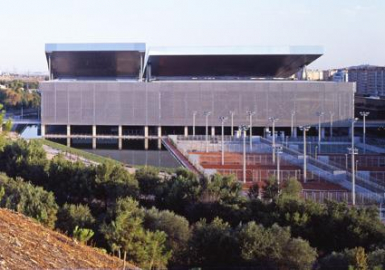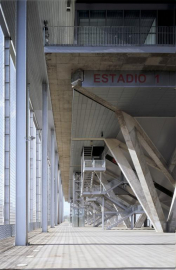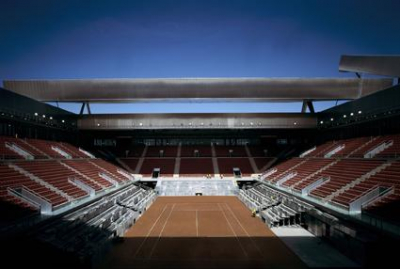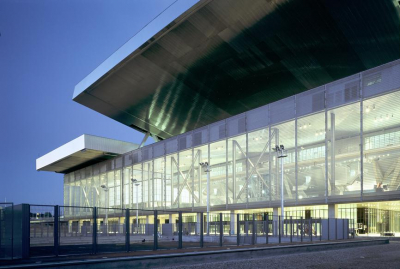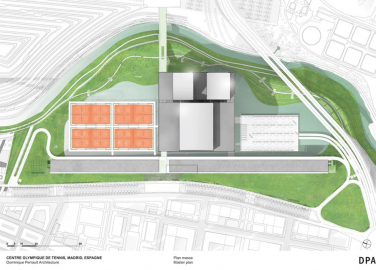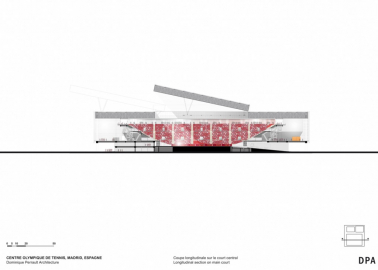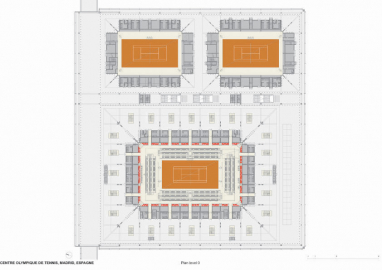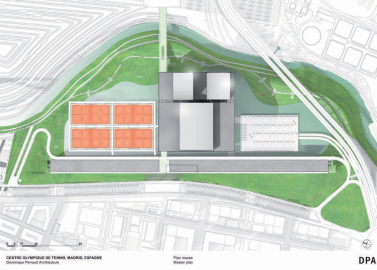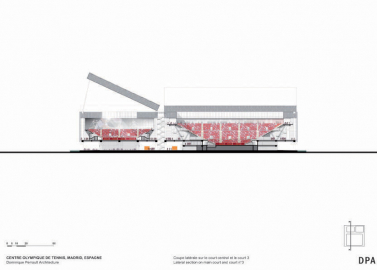Caja Mágica - Olympic Tennis Center
In the prospect of being a candidate for staging the Olympic Games in 2016, the Spanish capital begun a campaign to build spectacular facilities, among them the Olympic Tennis Centre. Working in an indistinct peripheral area, the issue at stake was not so much to design a building as to stage manage architecture and invent scenery.
With a plot area of 16.5 hectares, the site is located on a former slum housing area, previously a wasteland in the middle of a busy motorway and train network. The 100,000 square meter built project includes the magic box with three indoor /outdoor courts for 20,000 spectators (12,000, 5,000 and 3,000 respectively), 16 outdoor courts, five courts for 350 spectators each, six practice courts, a pool, headquarters for the Madrid Tennis Federation, a tennis school, clubhouse, press centre, stadium boxes and other private areas and restaurants. Built areas, made of steel, aluminum, concrete and glass, are organized around a vast artificial lake over which volumes of varying sizes are scattered, like islands or fragments of nature beckoning strollers. A system of footbridges opens numerous paths through these volumes, offering spectacular new perspectives and connecting the magic box with the San Fermin neighborhood and the Manzanares river Park designed by Ricardo Bofill.
Inside, the tennis arenas are adapted to the different uses of the complex. The roofs of the three indoor/outdoor courts are giant mobile slabs mounted on hydraulic jacks, which serve to partially or totally open the three roofs. The three aluminum clad roofs together provide a combination of 27 different opening positions. The roof of the central court, which measures 102 x 70 m and which weighs some 1,200 tons, can have a vertical opening reach of up to 20 m while the horizontal opening can slide as much as its width. Both the smaller stadiums roofs measure around 60 x 40 m and can open vertically up to 25 degrees.
They can also slide horizontally, leaving the inside of the stadiums completely open to the sky. Even in the worst weather conditions, Madrids Olympic Tennis Centre can hold a minimum of three simultaneous matches, the only tennis premises in the world to offer such flexibility. This versatility allows it not only to celebrate almost any kind of sports meeting, but also a significant number of other events. A special mesh design has been newly developed for this project. The size of the metal mesh panels of the main building (25 m high by 7.20m wide) is also pioneering. The new iconic landmark is endowed with a large park, above the water level, allowing it to be a public space to be used by pedestrians day or night, whether or not competitions are being held. The area is linked to Madrids cycling routes and has an underground station within a five minute walking distance. The architecture of the magic box changes the configuration of the city, standing as a powerful signal, permanent new landmark, and a new entrance.

